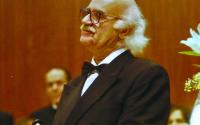Western Washington University senior Molly Ayre-Svingen recalls being shocked.
Standing in a classroom, she and other members of a group called Students for Renewable Energy asked fellow students in 2003 how much they would be willing to pay a quarter to ensure that their campus consumed only renewable energy. The questioning started at $1 and rose to $20.
"A huge number of hands were still up after 20 bucks," Ayre-Svingen said.
Just two years after that classroom revelation, and backed by a student body vote, the university has become one of the nation's earliest major adopters of purely green power. The Bellingham school also finds itself at the forefront of a rising campus movement across the state and the nation.
Soon after eco-conscious Western students voted to tax themselves to make their school the 22nd largest green-power purchaser in the nation, students at The Evergreen State College in Olympia took similar action. School initiatives like these are now under way across the Northwest -- a movement that has implications not only for campus politics, but also for the energy industry.
"We see a trend in university purchases across the country," said Rob Harmon, vice president for renewable energy programs at the Seattle office of Bonneville Environmental Foundation, which markets green power to public utilities.
Beginning this academic year, all power purchased through Puget Sound Energy at Western's and Evergreen's campuses comes from renewable energy sources, which include wind, solar, landfill gases, and biomass. Hydroelectric power is renewable but is typically not classified as green because hydropower is considered more damaging to the environment.
"There's a lot of energy on campus for this kind of thing," said Brad Bishop, an Evergreen senior who led the student green-power initiative movement. "It's pretty exciting."
In recent years, many utilities have begun offering their consumers the ability to elect green-power-only accounts. The cost tends to run 20 percent to 30 percent higher, but as more customers insist on renewable energy, the cost of those power sources is expected to decrease.
Though private companies, and not universities, were the earliest purchasers of green energy from Bonneville Environmental Foundation, universities now represent a fast-growing market, with Western and Evergreen among the most aggressive.
Those two schools' green-power policies alone have dramatically increased Bonneville's purchasing of green energy, Harmon said. Most of the power comes from wind farms, and in the past six years, the number of wind farms in the Northwest has grown from one to around a dozen.
Western and Evergreen aren't the only Northwest schools moving toward green power, though few have taken such sweeping steps.
The University of Oregon's student government chose to spend $100,000 of student funds to install solar panels on university rooftops. The system, consisting of 84 solar modules, was completed last February at the Eugene school. Oregon State University in Corvallis began purchasing some of its power as solar and wind energy in 2003. Eastern Washington University has had informal discussions with the city of Cheney about green power but has not made any serious steps yet, said Eastern spokesman Dave Sonntag.
The University of Washington has yet to implement a green power program, but UW spokesman Bob Roseth said the university is exploring the possibility. Aaron Best, who led the Sustainable UW Alliance student group last year, said the group focused on passing green buildings legislation in 2004 and put green power on the back burner, but now plans to address the issue.
Since the UW campus is far larger than Western or Evergreen -- nearly 40,000 students at the UW, compared with Western's 13,000 and Evergreen's 4,200 -- purchasing 100 percent green power would carry a far greater price tag. Roseth said he estimates energy fees from UW's provider, Seattle City Light, would rise by 30 percent, or around $4 million, if UW followed Western's lead.
"Costs do play a significant role in the decision," Roseth said.
Green power is currently more expensive than traditional gas or hydroelectric purchases because the technology is newer and not as widely used. In Washington, most green power purchases come from wind projects, which are expensive to build but cheap to operate.
As a result of the current price differential, green power still represents a small percentage of all power purchases -- just 1 percent in Washington -- but the portion is climbing sharply. Washington power customers purchased 67 percent more green power in 2004 (86.8 million kilowatt hours) than in 2003 (51.9 million kilowatt hours).
As renewable energy projects become more common, the price difference continues to narrow, said Tony Usibelli, director of the energy policy division at the state Community Trade and Economic Development Department. Natural gas prices are simultaneously rising, making gas less appealing to consumers.
The extra cost of green power at Avista Utilities in Spokane, for instance, dropped from a cent more per kilowatt hour in 2001 to three/tenths of a cent more today, with current base costs ranging from 6 to 9 cents per kilowatt hour. Usibelli predicts that green power will no longer be more expensive than natural gas in the near future.
"I think we're getting close to that point," Usibelli said.
For now, universities are relying on student body support to push green power. Western's movement began in 2003, when students studying renewable energy in a Western course learned that homeowners could opt to purchase green power from Puget Sound Energy.
"We thought, `Imagine if all of Western could do that,'" said Ayre-Svingen.
Last school year, Students for Renewable Energy collected more than 2,000 signatures in three days to put an initiative on the spring ballot that asked students to pay an additional fee of up to $19 a quarter for Western to purchase 100 percent green power. The measure passed with 84.7 percent support. Beginning this school year, Western students pay $10.50 a quarter.
"The initiative passed overwhelmingly," Ayre-Svingen said. "This was a real organic, grass roots, student-run effort."
The initiative at Evergreen found similar support, with 91 percent approving a green power fee early this year. Evergreen students now pay $1 extra per credit hour for renewable energy. A newly formed Clean Energy Committee will use some of the funds for additional conservation projects and energy education. Steve Trotter, executive director for operational planning and budget at Evergreen, said he hasn't encountered opposition to the fees.
"Just like all fees, I'm sure parents have questions, but I know students were very careful about doing outreach," Trotter said.
Bishop at Evergreen said debate over the initiative focused not on the added cost, but on whether money should be spent buying green power from a utility or building on-site renewable energy projects. In the end, Evergreen split the revenue from the fee, with 90 percent going to green power purchases and 10 percent going to the Clean Energy Committee projects. Bishop said student leaders at UW tell him they are debating the same issue right now.
Trotter believes Western and Evergreen are logical starting points for renewable power student movements in Washington because the two universities are known to embrace green issues. Evergreen students already pay a self-imposed fee to ensure all students have access to public transit.
"I think both institutions have a lot of commonality on environmental movements," Trotter said.






